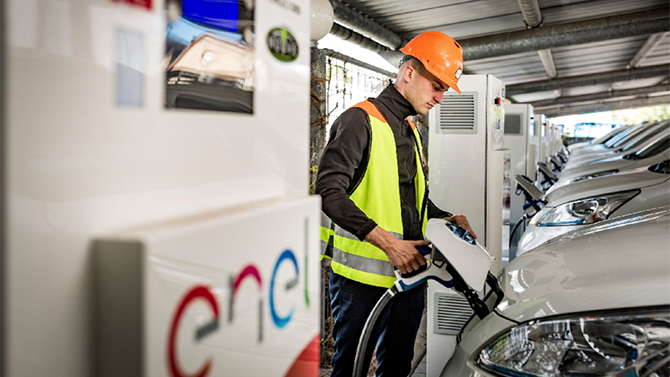


Plugging renewables into global grid
Photo courtesy of Nuvve December 15, 2016
OEIP helps startup gain worldwide rights to UD’s vehicle-to-grid technology
Imagine the possibilities for drivers around the world if they all could plug their vehicles into a charging station and connect directly to the grid, to either recharge or send their surplus energy back.
University of Delaware researchers have been developing such technology for about 20 years, and now their licensed startup company has gained exclusive global rights to market their vehicle-to-grid (V2G) software.
The University recently entered the exclusive licensing and research partnership with the Nuvve Corporation, a Delaware company located in California. Before this agreement, the rights to commercial application were split between a domestic venture with NRG Energy and a partnership with Nuvve for rights outside the United States.
V2G technology allows electric vehicles that are plugged into a charging station equipped with UD’s Grid Integrated Vehicle (GIV) software to charge or discharge their batteries back to the electric grid based on real-time requests.
The software aggregates all vehicles plugged into the system so that they perform as a single power plant, helping to balance the grid’s supply of electricity with demand — on a second-to-second basis.
“As more and more variable generation capabilities such as wind and solar are installed, the value of high-quality balancing services is increased,” said Willett Kempton, professor in UD’s College of Earth, Ocean, and Environment and College of Engineering. “This is just the right time to be launching this service commercially.”
Kempton, who serves as research director of the University’s Center for Carbon-free Power Integration, leads the UD team that developed most of this technology.
Another bonus? The vehicles’ owners get paid every time their energy is used by the grid.
“In an environment where the cost of renewable energy generation is dropping drastically, a flexible and cost-effective way of storing it is absolutely required,” said Gregory Poilasne, co-founder and CEO of Nuvve. “The availability of our platform in supporting the transformation of the grid is catalyzing the adoption of electric vehicles.”
The development and commercialization of the V2G concept, platform and associated technologies began in 1997 when Kempton and his colleagues invented the first pieces of the technology. After years of research and development, UD entered into a joint venture with NRG in 2012 to commercialize the technology in the United States.
A four-year research partnership between NRG and UD led to a commercial demonstration of the technology at the University’s Science, Technology and Advanced Research (STAR) Campus in collaboration with BMW, the car manufacturer, and PJM, the local grid operator.
That partnership also included a research and development agreement with Honda North America to develop V2G-capable vehicles. Several of those vehicles are now being evaluated for applicability to the U.S. market.
OEIP serves as liaison
UD’s Office of Economic Innovation and Partnerships (OEIP) served as the liaison between Kempton’s team and outside partners. Acting on behalf of UD’s interests, OEIP has been an important factor in the development of the research and business partnerships associated with the development and commercialization of the technology.
“The cornerstone of the development of the V2G technology has rested on relationships and collaboration with industry partners,” said OEIP Director David Weir. “Through the many periods of transition in this journey, OEIP played an important role in maintaining the continuity of the conversations and the goal of a global license as the best outcome for all partners.”
The journey toward commercialization that began with NRG changed this past summer after NRG sold its electric vehicle charging infrastructure business — EVgo — to Vision Ridge Partners, a Colorado-based investment firm focused on accelerating the transition to a low-carbon economy.
With the transaction, EVgo’s main focus became the continuing development of its nationwide fast-charging network, which requires providing customers with the fastest charge and shortest parking period possible, whereas, V2G requires longer parking periods to interact with the grid.
Though EVgo’s focus has shifted, the company has taken a small ownership stake in Nuvve to support the continued development of the V2G technology.
“We have a very high regard for the work that Prof. Kempton and his team are doing,” said Scott Fisher, director of market development at EVgo. “We’ve also been impressed by the traction Nuvve has been making in the European market, and we look forward to seeing their progress in the U.S. market.”
The resulting combined license agreement demonstrates the effectiveness of OEIP’s strategy to build long-term, mutually beneficial relationships around UD’s intellectual property.
Nuvve is now applying the technology commercially with grid operators in Denmark, the Netherlands and the United Kingdom. Technical development continues at UD’s STAR Campus in partnership with PJM. With the newly consolidated global license, Nuvve is expected to expand commercial operations in other regions of the United States as well.
Contact Us
Have a UDaily story idea?
Contact us at ocm@udel.edu
Members of the press
Contact us at 302-831-NEWS or visit the Media Relations website

